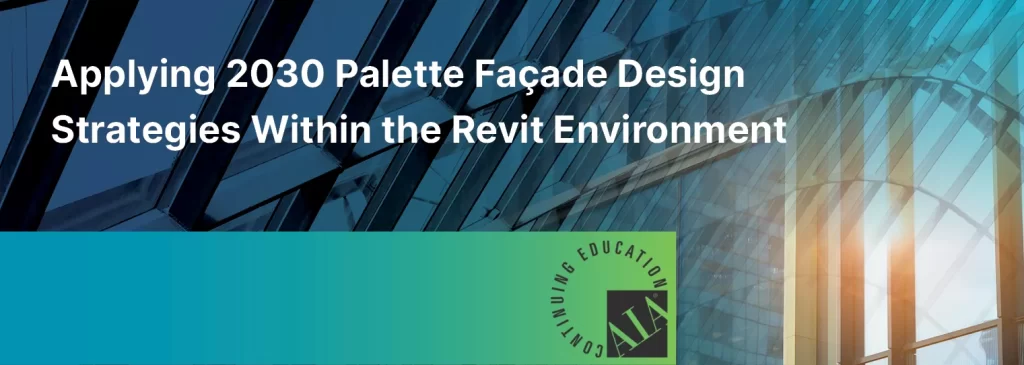Architects, designers, and engineers can earn free AIA credits by attending our webinars. We offer virtual lunch and learns and individual courses.
CONTINUING EDUCATION WITH AIA
Free Courses For Indivduals and Teams

Our Courses
- Passive Considerations in Facade Design: How Energy Affects Building Performance
- Applying 2030 Palette Façade Design Strategies Within the Revit Environment For New and Existing Buildings
- Effective Workflows for Dynamic Energy Modelling in Revit
- How Glass and Glazing Systems Affect Building Energy Performance

Passive Considerations in Facade Design: How Energy Affects Building Performance
Program Description
Optimal design decisions relating to the envelope are crucial to managing the energy performance of a building, particularly around passive design strategies of the façade. During this 1-hour online course, you will learn how geometric and materiality considerations can differ between design stages. We will look at goals and objectives relating to the façade at SD, DD and CD, and the utilization of different software applications to achieve these goals. There are no prerequisites for this course.
Course Credits
1 LU | HSW
Learning Objectives
- Determine the differing end uses of energy consumption affected by the façade, and how they relate to overall building energy performance.
- Utilize building information modelling tools to meet project design stage requirements regarding façade performance.
- Investigate solutions around the geometry and materials of the façade to optimize passive design strategies of the building envelope, and at what stage these decisions are best made.
- Review case studies of façade design strategies on projects at different design stages – Schematic Design, Design Development and Construction Documentation.

Applying 2030 Palette Façade Design Strategies Within the Revit Environment For New and Existing Buildings
Program Description
How we manage, plan, and design our built environment will determine whether climate change is manageable or catastrophic. With the 2030 Palette, designers have the tools they need to design adaptive, resilient, and Zero Net Carbon built environments.
This presentation outlines how the principles and strategies of the 2030 Palette for façade design can be applied to new and existing buildings at different design stages, and how to get a better understanding of the implications of design decisions.
It will cover the effects of passive characteristics such as solar, thermal and daylighting, and how these can be managed and optimized through decisions around geometry and materiality at the earliest stages of a building design process.
Course Credits
1 LU | HSW
Learning Objectives
- Understand the impacts of existing building facades and the need to design new buildings that are adaptive and resilient to transform our built environment.
- Identify the benefits of passive design strategies relating to the façade.
- Determine appropriate façade design strategies of the 2030 Palette to optimize building performance at differing stages of the architectural design process.
- Utilize building information modelling tools to understand the effects of these strategies in real-time.

Effective Workflows for Dynamic Energy Modelling in Revit
Program Description
Energy Analysis Models in Revit can be inflexible and not create space adequately. Performance can be slow and large models are often difficult to navigate. However, we have created new workflows that can improve and resolve issues relating to the envelope, giving modellers dynamic feedback on their façade design decisions. These workflows will be discussed and demonstrated throughout the course.
Course Credits
1 LU
Learning Objectives
- Understand common issues from the Revit Energy Analysis Model and learn about new workflows to address façade design decisions.
- Interpret Revit models to calculate rapid envelope analysis in a separate viewer.
- Dynamically analyze the energy performance of the facades to investigate different design decisions.
- Apply design decisions to native Revit families and embed them in the model.

How Glass and Glazing Systems Affect Building Energy Performance
Program Description
Glass has been one of the most important architectural materials for centuries. It is essential in delivering beautiful aesthetics, visibility, and light transmission to our buildings. This course provides an overview of the considerations and implications of using different types of glass and glazing systems, how these decisions have demonstratable impacts on the energy performance of a building, and how designers can optimize their selection in design and specification processes.
Course Credits
1 LU
Learning Objectives
- Understand how different glass types and glazing systems are applied and specified, including design considerations, benefits, and challenges.
- Interpret how different selections will impact the energy performance of a building, particularly in how it relates to the façade for thermal, solar, and daylighting considerations.
- Explore how you can optimize your selections dynamically and accurately in the Revit environment. Designers will learn how to apply their design decisions to the building information model (BIM).
- Learn about innovations and the future of glazing specification in BIM workflows, from concept to fabrication.
AIA CES Provider Statement



The course is provided by FenestraPro, a registered provider of AIA-approved continuing education under Provider Number 10009325. All registered AIA CES Providers must comply with the AIA Standards for Continuing Education Programs. Any questions or concerns about this provider or this learning program may be sent to AIA CES (cessupport@aia.org or (800) AIA 3837, Option 3).This learning program is registered with AIA CES for continuing professional education. As such, it does not include content that may be deemed or construed to be an approval or endorsement by the AIA of any material of construction or any method or manner of handling, using, distributing, or dealing in any material or product.
